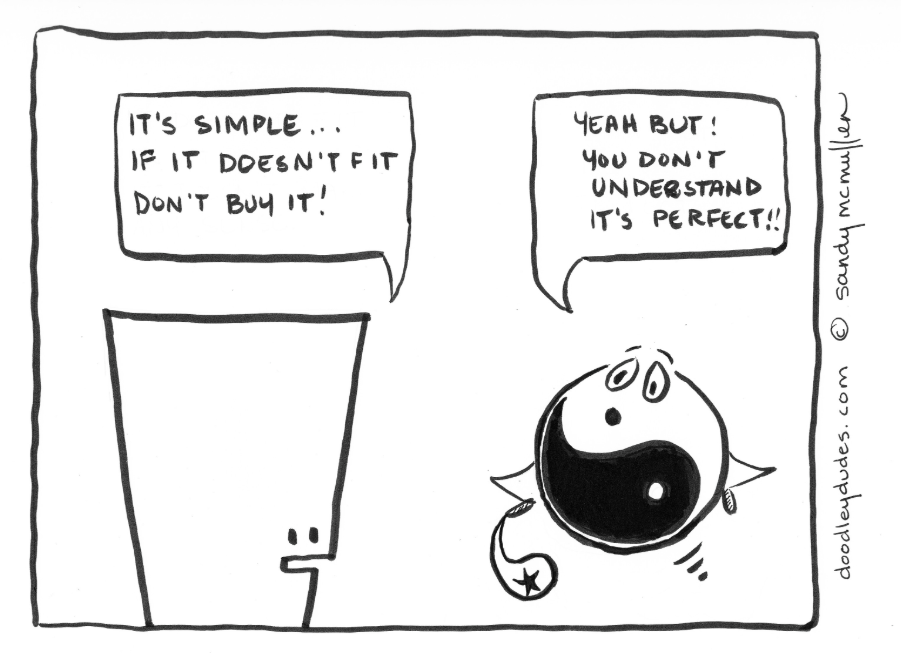
by Sandy | Aug 8, 2018 | Best Practices, MBTI Facts
Imagine a work environment where everyone has their MBTI type label posted on their office door. This may strike some as just terribly efficient. But no No NO NOOOOO…this is just bad practice and a misuse of the MBTI or any other assessment tool IMHO.
People are NOT any label that you might hang on them, and this way of viewing the use of assessment tools does a disservice to everyone. MBTI professionals are very careful in their language to make the distinction. They will talking about “those with a preference for Extraversion” as opposed to “those who ARE Extraverts”. People are wonderfully complex and they definitely should not be limited by any label. People HAVE a preference – they AREN’T their preference. This distinction matters.
When you hang a sign on a door that limits possibilitites for genuine engagement. People can make all kinds of false assumptions based on too little information and misunderstanding. It is an act that separates us from each other rather than building true connection and compassion.
Knowing that someone may have a different type helps me to understand how they process information and make decisions differently from my way of being. I don’t have to take their behaviour as a problem or weird or even better than mine – simply different. If I spend some time observing myself I may even come to appreciate the benefit of how their type handles some situations where my way of processing may have blind spots.
Yes – use the MBTI to learn how to communicate with other styles. Yes – use the MBTI to find work that fits your natural ways of being. Yes – use the MBTI to learn to see and appreciate each other and to share in a way that builds trust. This approach involves real conversation about our different perspectives and a desire to learn and understand those with whom we work. Putting type labels on office doors may do the opposite – contributing to judgment and alienation. Don’t do it even if you think people will be okay with it – it may seem harmless but it isn’t.
Other folks had something to say about this too:
From Hunter Nuttal
Forcing people to post their MBTI type on their doors would surely be resisted by a lot of people. I’d like it personally, but many people freak out about being labeled.
Notice that we only mind labels when they’re negative. Face it, we couldn’t communicate without labels. We label ourselves with names and job titles, we say “I’m a motorcycle enthusiast” or “I’m a pizza lover,” we like it when people call us “smart” or “nice.”
All these labels are fine, but call someone by a label that sounds negative, and they’ll suddenly be all “Don’t label me!” As the MBTI labels are simply about our preferences, none of them are bad. It doesn’t make sense to be offended by your own preferences.
I think people resist these labels because they don’t understand them. They think that learning your type somehow limits your options, or tells you that you’re bad at something. Nonsense. Knowledge is power.
Another thing is that everyone is labeling us anyway. Remaining ignorant about our type will do nothing to protect us from peoples’ negative judgments. I’d much rather be called an INTP by someone who’s been educated about the MBTI, rather than be called “shy,” “flaky,” “heartless,” or “lazy” by uninformed people.
BTW, I’m building a list of peoples’ self-reported MBTI types. My URL points directly to that, if you want to take a look.
From Stephen
James Flaherty, in “Coaching – Evoking Excellence in Others”, points out that personality profiling leads us to expect certain behaviours from others which influences that person’s behaviour and frames our observation of that person. And these two factors, coupled with laziness leads us into one of the main hindrances of coaching, which is to understand people as a collection for fixed properties with desire attached.
In the book he proposes assessment models which he claims give form and shape to our observations without limiting the person to parameters.
The idea of putting MBTI labels on office doors is exactly what he is highlighting. It is easier to say – “She is an ISTJ” than it is to understand and formulate a view of her concerns, commitments, history, future possibilities, mood, domains of competence, Intellect, emotion, will, context and soul (to outline JF’s assessment models).
I have used MBTI in exercises with teams, allowing people to comment and draw comment on what they agree with and what they don’t. In my experience this has provided an excellent framework, for mutual understanding. In coaching however I have started using JF’s (and others’) approach. Having said that, I also know that MBTI takes us to the same understanding if we are prepared to do the hard work required to get beyond a tetragrammaton.
Sandy, what process do you build into your work to prevent the kind of response you describe in this posting?
From Me
A few things come to mind about how I work with the MBTI with people. First is that I have a commitment and intention behind my coaching practice. I believe that we do the best most fulfilling creative and sustainable work when our actions are congruent with who we are.
Tools like the MBTI and Enneagram and Reiss are mirrors to use to see a more accurate reflection. All of this happens in the context of a conversation that has a purpose behind it.
For example, any MBTI workshops that I have done as an associate of Context Management Consulting Inc. have been part of a larger strategic framework. Context works to implement strategy through ongoing Action Learning groups in cross functional teams as well as regular retreats for intact teams etc. The MBTI workshops were integrated into these retreats when appropriate and linked to a larger context.
In additon to the workshop individual coaching followed. Some of the focus integrated the Hay groups Emotional Competency Inventory and the insights from the MBTI to help deepen the learning and build capability.
Two things stand out – that the MBTI was part of a leadership development strategy – that there was both a group and individual opportunity for reflection on applying insights.
It was not delivered as a “one off” event that was entertaining or interesting. As I mentioned in my post above I am also careful with language and asking permission to share personal information during the workshop or coaching. My intention is to set the stage for people to take the risks to have a more meaningful conversation (a least that’s the plan) Creating this kind of container for good work to happen is subtle and an art form. When it happens I celebrate when it doesn’t I learn and go on.

by Sandy | Aug 7, 2018 | Personal Expression
The fallacy of going it alone
Independence has often been heralded as an essential quality – overtly for entrepreneurs and as a sub-text for others such as high performers on their way up the corporate ladder similarly for senior leaders. It is part of a particular mindset that one can associate with words such as ‘go-getter,’ ‘self starter,’ ‘fast track,’ and that oh so overused word ‘maverick.’
The Reiss Desire Profile of Motivational Tendencies, an assessment of 16 core motivators, helped me to see the role that Independence plays in my own behaviour. The old adage about your biggest strength if overused becomes a weakness holds true when it comes to Independence. Since my pattern is to be unconscious about asking for help, I need to be intentional about creating ways to reach out to others.
Changing Landscape
Everywhere you look, you find moment to moment examples of the increasing levels of complexity that face us on a personal and organizational level. You have to navigate through new technologies that impact how we communicate and process data. Even if you are a techie there can be a certain fatigue or unnatural over-excitement and dissatisfaction that come from being on this treadmill. Client needs are continually expanding while resources are often dwindling. There comes a point where you realize that you cannot do it all by yourself. Even if you could, you run the risk of being blindsided that you didn’t anticipate.
An important part of your strategy
Here’s where “reaching out” steps into play a critical role. Who do you turn to when you need some input that you can trust? Before you get to the point of overwhelm there is tremendous value in being intentional in creating a community so that you are not working in isolation. I don’t have one definition to offer for community but I have a list of examples of places where I reach out. You might find an idea to try.
Mastermind: Typically of group of 8 to 10 from diverse business backgrounds that meet once a month to talk about their business challenges.
Trusted Advisors: People who know your work as a result of collaborations or parallel interests and are open to being in conversation with you about things you may be considering. They may or may not be friends but they are people that you can trust and who you know will give you the straight goods and who also appreciate your support and input.
Professional Associations: Meetings and conferences offer learning opportunities
Virtual Communities: Online discussion forums where you can get instant input often from a global community
Learning Community: These may take various forms. I have two groups that I value. One is a group that has continued to meet 4 years after a coach training to share best practices and new learning. The other is within the consulting company where I am an associate where professional development and ongoing group learning is an embedded value and practice.
Board of Directors: An idea that is not just for corporations – When you are considering a major shift think about convening a group of knowledgeable individuals from various arenas to guide you. You may be surprised at just how willing people are to help if you approach them in the right way.
Your clients and customers: Perhaps your greatest source of help, support and information if you ask.
Before you reach out to others consider how to truly benefit from this approach:
- Set aside the role of expert
- Listen objectively without need to judge or justify
- Allow space for input to percolate and for new ideas to emerge
- Try out the ideas that a fit before you have every wrinkle resolved. Senge, Scharmer, Jaworski and Flowers espouse the value of prototyping in their work “Presence.” You will know quickly enough whether to adjust or abandon an idea.
Reaching Out has beneficial side effects:
Not only do you get a clearer perspective on the big picture and pieces that may be blind spots for you, but also in the long run you end up with a better result than you could have by clinging to “going it alone”. There is also a paradox at play. When you are honest in bringing a genuine question to the table it builds trust and confidence in your capabilities rather than diminishing your position.

by Sandy | Aug 6, 2018 | Enneagram
The Enneagram is a model of nine distinct personality types. This may sound like something that could offer an simpler model than the MBTI (Myers Briggs Type Indicator). Nine types compared to sixteen of the MBTI – right?
My experience is that the Enneagram provides richness and depth and that, in fact, it demands a deeper commitment than the MBTI. So why bother?
Somewhere along the career path some folks run into territory where a mechanistic or tactical approach simply won’t provide any answers. What to do next becomes a spiritual journey. When that happens the Enneagram offers a window to an uncannily accurate look at who you are and how your worldview shapes your reality.
It requires some work to have this kind of conversation – even if it’s with yourself.
In case I have scared you off completely, the Enneagram can also be viewed on a simple practical level and can work well in conjunction with the MBTI. For example, my Enneagram type six is sometimes referred to as the Loyal Skeptic. My worldview is that the world isn’t always what it seems on the surface. The quest of the six is searching for certainty. The point of growth is in recognizing that certainty doesn’t exist. The other part of the path of growth for the six is to learn to trust that no matter what the circumstances they will be able to handle what comes their way.
In a real work situation my style is to “be prepared” beyond what might be required so that I can have the flexibility in the moment to throw it all away and respond to the needs of the people in the room.
I also have a strong influence from the Enneagram type seven that is aligned with the optimistic, cheerleader aspects of my MBTI ENFP preferences. The Enneagram helped me to understand the fear and doubt that often runs silently below the surface of my enthusiasm.
Curious about yourself? Want to see more of the model?
Here is a mini- quiz that has 38 0f the 144 questions on the Riso-Hudson Enneagram Type Indicator (RHETI). As with any quiz it is also important to confirm your type in addition to the results of the assessment tool.
I can help you to clarify your results and to apply what you understand about your type to your work/life situation. Send me a message.

by Sandy | Aug 1, 2018 | Best Practices
Not every organization embraces using coaches but more and more people are using coaching skills in the workplace. Both coaches and managers using coaching tools can hone their coaching skills.
During a recent conversation that was ostensibly about an upcoming presentation, I was reminded about the role that Sensing plays as a coaching capability to be developed. The person was focusing all of their energy on getting the words exactly right and in including every point. The further they went in this direction the more their posture shifted … eyes downcast, voice low and mumbling and shoulders slumped. A winning presentation would depend more about being in a resourceful “state” than getting the words perfect.
This person knew the material so well they could have written a book about it so what was the story that the body was telling?
Noticing these changes provided an opportunity to identify what was going on and to shift the focus to where it needed to be in order to get a good result.
It is easy to think that content is king and to pay all of our attention to what a person is saying. What usually matters more is focusing on being present and using sensory cues… such as breathing, changes in tonality, posture or coloring.
These changes may indicate an opening worth investigating with genuine curiosity. If we are trapped in only following the logic of the thread of what the person is saying we could miss the moment. Openings are the real royalty.
In an insightful article on coaching in organizations Michael Bungay Stanier points out the value of “just in time” laser coaching. Openings don’t take an hour to notice. Coaching is more about how you pay attention and not at all about having the answers. Call on the Sensing function to focus your attention in the moment.

by Sandy | Jul 24, 2018 | MBTI Facts
The Theory
The Thinking preference makes decisions objectively based on matching to rational, logical criteria.
The Feeling preference has a decision-making process that is subjective and is based on values and how the decision will affect the people involved. It is a rational process – the criteria are different.
So that’s the theory.
The Reality
This difference can be the cause of a lot of misunderstanding in relationships. I love this cartoon because from a Thinking perspective this purchase makes no sense, but how many people have had this very moment in their shopping experience. This cartoon is at the expense of the Feeling preference so I’d like to point out the value Feeling makes in contributing to harmony and well-being. Better decisions are made when both Thinking and Feeling are considered.
Disclaimer
BTW if the joke was on the other foot I wonder if Thinking types would react. They might be irritated, or they might not even notice. “It’s not personal.” could almost be a Thinking mantra.




